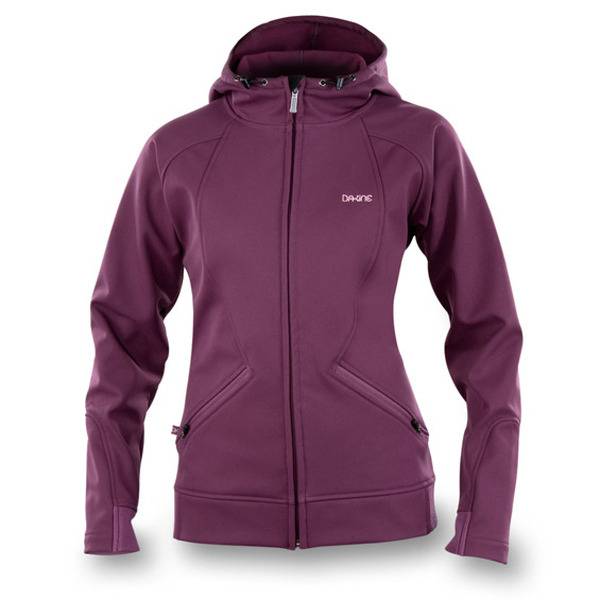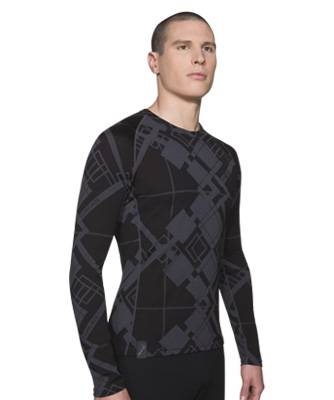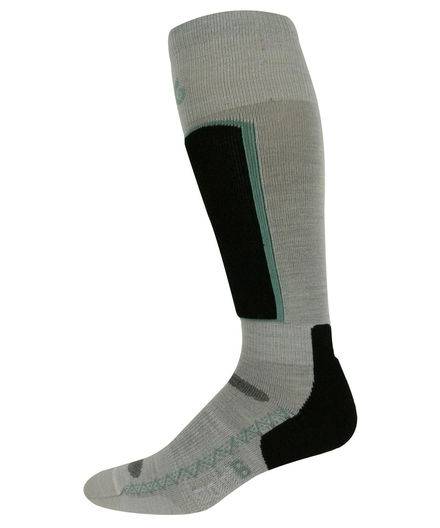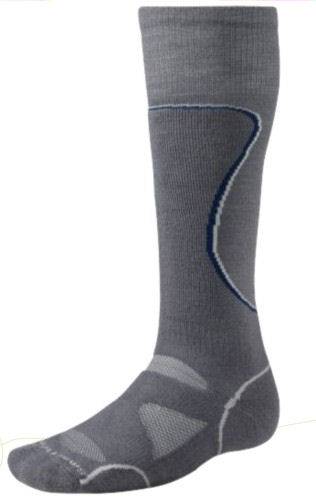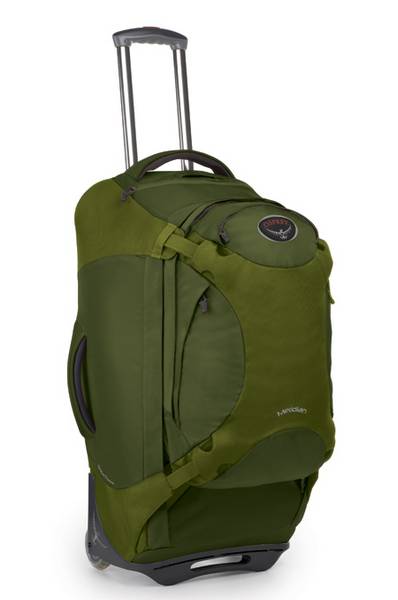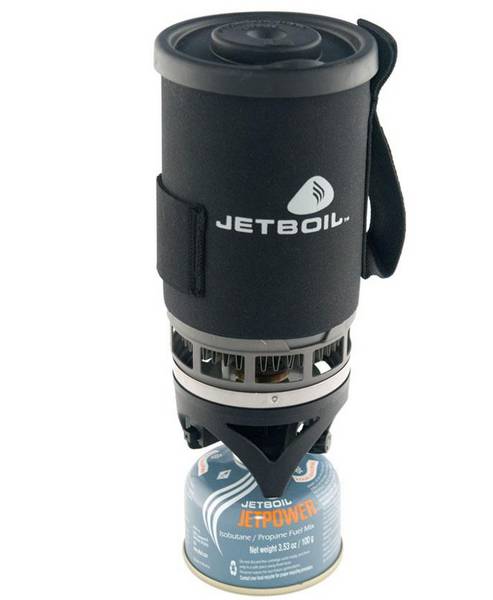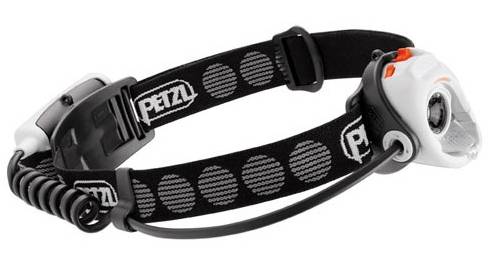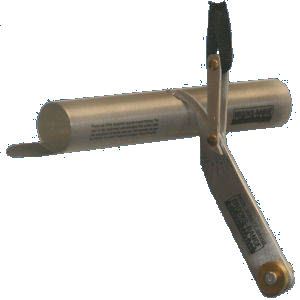Salt Lake City, UT – If you haven’t looked at the calendar lately, Christmas arrives next week. Next week! If you’re looking for a last-minute gift for the skier or snowboarder in your life we’ve reviewed a collection of products this year that would look perfect wrapped under the Christmas tree. Or if Grandma gave you another argyle sweater this year, exchange it for something you can use for the slopes!
Apparel
In today’s iPhone world high tech is in, and several of this season’s new apparel offerings are no exception.
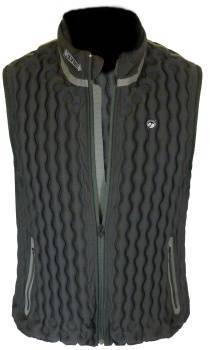 Klymit’s Double Diamond vest |
One of the most exciting ideas to come down the pike in a while is to use gas instead of fiber for insulation. Klymit, a Utah company founded by entrepreneur Nate Alder, has been experimenting with using inert gas as an insulator for a couple of years now and this year has launched its first series of products with the Double Diamond ($224.95) aimed at winter sports athletes. What makes the Klymit vest special is its versatility — there’s no need to layer up in the morning and strip down in the afternoon. Too cold? Inflate the vest further with the company’s patented “HotShot Kanister” and Klymitizer delivery system. Too warm? Let some of the noble gases out to deflate, but don’t worry…the argon gas is safe for the environment. The vest nonetheless breathes to let moisture out while keeping warmth in. Using air as an insulator is lighter and more compressible than fiber, and the Double Diamond comes complete with a stuff sack to throw in your pack along with three HotShot canisters and a Klymitizer.
The vest is well constructed and features a high-rise neck and two slash pockets. Even though the vest is less than half an inch thick when fully inflated, we found it to feel a bit stiff to wear when under full pressure although our testers became more accustomed to the feel over time. Keep an eye on Klymit, for the company has plans to deploy its technology in products ranging from sleeping pads to ski boots.
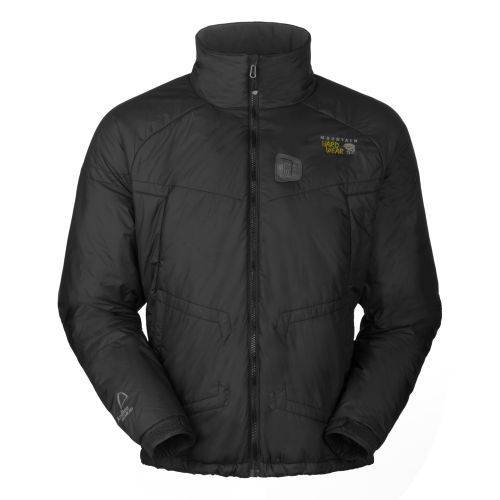 Mountain Hardwear’s Refugium jacket |
Speaking of the iPhone world, use your portable device to stream music for a full day on the slopes while making phone calls from the lift and you may well have a dead battery by mid-afternoon. That’s where the new Refugium jacket from Mountain Hardwear comes in. This short insulated jacket carries a battery pack called the Ardica Moshi Power System that not only provides electric heat on demand, but also powers portable devices via a USB outlet in the left pocket. During some cold days in Utah earlier this month our testers reached first for the Refugium. The heat is delivered at one of three settings, and while unlike some other heated jackets it’s only delivered in the thoracic region of the back, we found it to be effective in that location. It felt like a heated seat in a car. We also found that the hottest setting depleted the rechargeable battery pack rather quickly, and the weight of the battery pack takes some getting used to, but these are minor issues for what is a revolutionary garment. As it’s not waterpoof/breathable it’s best to wear the Refugium underneath a shell on foul weather days. The jacket retails for $230, while the optional Ardica Moshi Power System will set you back another $145.
Editor’s Note: As of February 2010, the Refugium jacket was being recalled due to a safety hazard. More information is available here.
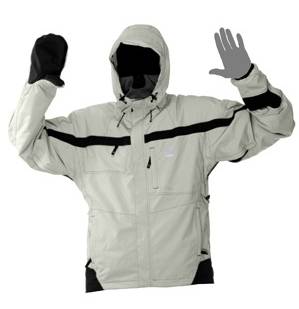 The Meta jacket from Loki |
Loki makes jackets with built-in mitts and face shields, and the company’s Meta jacket ($259) is aimed at the snow sports world. We’ve all had those cold marches to the base lodge from a distant parking lot as our hands went numb. A quick flip at the wrist, and the Loki Meta deploys built-in mittens to keep hands warm. If a breeze kicks up while riding the chair, a built-in face shield sits at the ready within the garment’s helmet-compatible stow-away hood to guard against frostbite. The fully seam-taped shell is insulated for warmth and includes generous two-way pit zips, a fixed powder skirt, a large storm flap, two exterior chest pockets, two slash pockets and two interior pockets, one outfitted for an MP3 player.
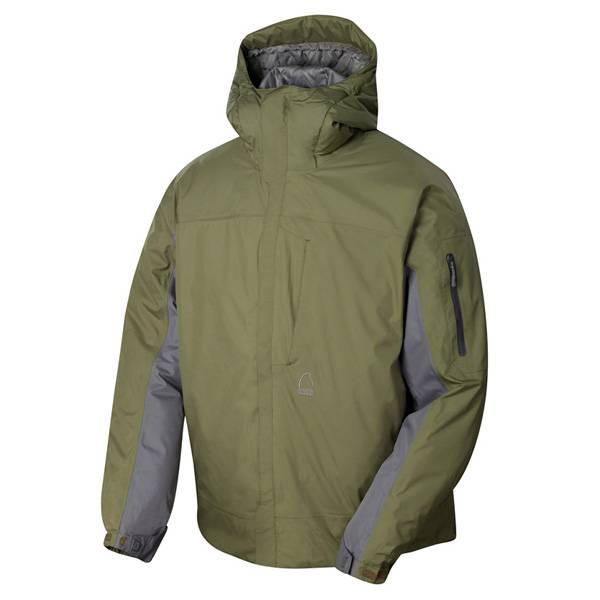 The Sierra Designs BTU Jacket |
This year our testers got to try a new down offering from Sierra Designs, the BTU Jacket ($299). It’s well named, for with its 800 fill goose down, waterproof/breathable shell and helmet compatible hood the BTU jacket kept us warm and dry. “I had to take off all but a short sleeve t-shirt under this jacket and I was still incredibly warm,” one tester commented. “This jacket is built for cold, harsh weather — no doubt!” The BTU would not only suit a skier in a cold, damp climate, but would also be a great belay jacket for ice climbing or for winter camping. We were only stumped by the hood pulls inside the jacket. While it’s clearly to give the jacket cleaner lines, we found it difficult to give the hood a snug fit.
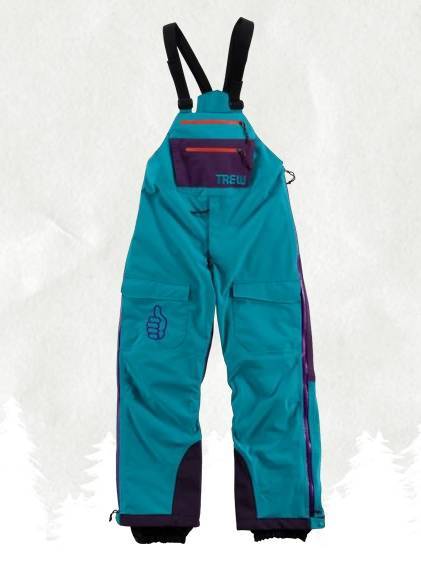 Trew’s Trewth bib |
A new startup called Trew has entered the very crowded market of ski apparel, and they hooked our testers up with their Trewth Bib ski pants ($399). While the colors may seem off the wall and reminiscient of the neon of the early 90s (they do have some subdued colors as well), these bib pants are bomber. Made with a burly fabric called Gelanots®, these pants are 20K waterproof/breathable, so you stay dry inside and out. The 70 by 140 denier Gelanots® fabric is a tear-resistant, rugged fabric intended for heavy outdoor use. Like we said: bomber.
Our testers recently got these out for a tour in the Wasatch, and all in all had good things to say. The cut is big — baggy, if you will. “You have a great freedom of movement,” commented one tester who skinned in the bibs on a warm Wasatch day and found the breathability to be superb. Full length side zippers dumped heat quickly. Our only complaint was that the boot gaiters were very loose with no way to adjust them.
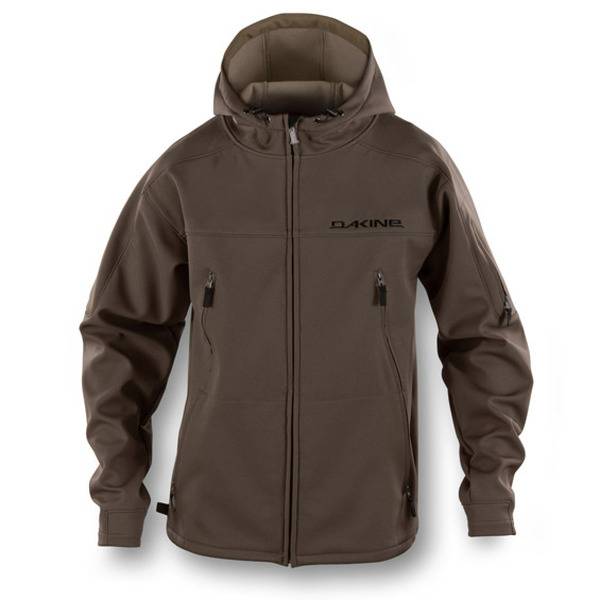 Dakine Airlift hoodie Dakine Transit hoodie The Oasis Crewe from Icebreaker |
Dakine has produced a pair of softshell hoodie jackets this season, the Airlift for men and the Transit for women, that very competitively priced at $130 and $120, respectively. Our testers found that these 10K waterproof/breathable soft shells were very effective at blocking wind and made an excellent outer garment for skiing in moderate climates. Both are stylish and the women’s cut is quite flattering, although our female testers would have preferred more pockets that appear in the Airlift.
Our testers remain huge fans of merino wool, especially for a base layer due to its odor-free moisture wicking properties, and merino doesn’t come any softer than from New Zealand’s Icebreaker. We tried an Oasis Crewe top ($89.95) that was stylishly printed and thus didn’t look like underwear in the base lodge, yet it has flat locked seams for comfort under other garments. The fabric was soft and plush to the hand, and the 200-weight merino was perfect for active sports like alpine skiing.
And when skiing is done and you’re ready for an evening in the resort, we have a new favorite pair of après-ski pants, the new Flannel-Lined Original Mountain Pants from Jackson Hole’s Mountain Khakis ($89.95). With triple stitching and burly cotton duck canvas the Original Mountain Pant will outlive their wearer, and these are lined from waist to ankle in plush cotton flannel for a cozy, warm feel. These relaxed fit pants have a gusseted crotch to make those long plane rides to the mountains more comfortable as well. For sitting around the fireplace at night it just doesn’t get any better than this.
Accessories
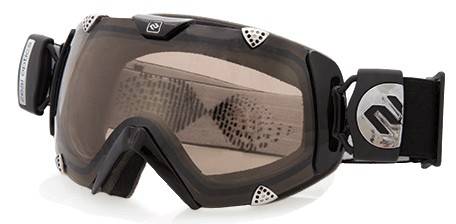 The Eclipse SPPX goggle from Zeal |
Some days go from bluebird to blinding snow, and with Zeal’s Eclipse SPPX polarized photochromatic goggles ($200) there’s no need to return to your bootbag to grab a different pair. The Eclipse SPPX’s lens is UV activated to adjust visible light transmission across a remarkable range from 41% on overcast and snowy days to 13% on bright, sunny days. The spherical polarized lens further cuts down on glare from snow and ice to enhance vision. At this price we’d sure hate to scratch them, but the cost isn’t much more than the price of two or three goggles to cover the same range of light conditions. Peripheral vision and visual acuity is superb, and the large size best serves those with medium to large faces. The strap connects to the frame with a very flexible rubber cord for maximum helmet compatibility, but as always, test the goggle’s fit with your helmet before purchasing any goggles.
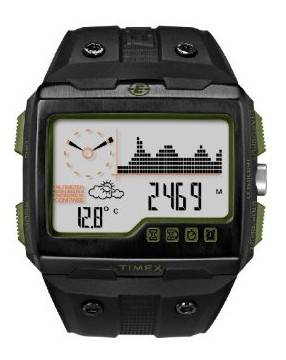 The Timex WS4 |
This year we recieved a new outdoors watch from Timex called the WS4 ($200). This feature-laden wristwatch’s most notable attribute is its large face that allows the display of four functions at once: time, temperature, and one button to scroll through altitude, barometer and date. Other features include compass, chronograph, countdown timer, and alarm with a five-minute snooze feature.
The WS4 will also track your trip’s statistics, whether laps at the ski resort, backcountry touring, or a summer hike in the mountains. The WS4 uses the chronograph, and its ability to accumulate up to nine “laps”, to track trip statistics. At the beginning of your trip just start the chronograph and the gathering begins. If you’re on a multi-day trip or ski tour you can use the lap feature to gather reference points. At the end of your day/trip you stop the chronograph and move into “review” mode. You’ll see total altitude (ascended and descended), time of trip, and temperature (high and low).
“The watch is very big,” noted one tester. “I wouldn’t wear this everyday, but when I’m out in the wilderness I love this watch’s features.”
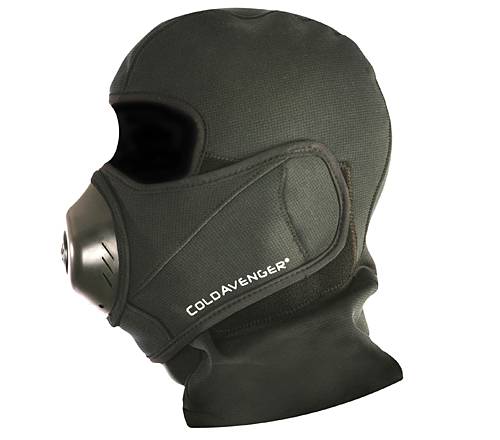 The ColdAvenger Expedition Balaclava |
Last year we tried the ColdAvenger Classic face mask from Talus and felt like a Darth Vader look-alike, a feeling that’s been accentuated this year by the company’s ColdAvenger Expedition Balaclava ($79.95). Say what you will about appearance, however, for you’ll never find more effective face protection anywhere.
The balaclava’s body is made of Polartec Wind Pro with Hardface technology to stretch to a comforable fit and block wind and is cut long to fully protect the neck. A removable medical grade polyurethane ventilator allows free breathing during high intensity exercise and prevents the wet fabric that can make a traditional balaclava uncomfortable. It casts an unusual fashion statement on the slopes, but the ColdAvenger Expedition Balaclava would prove indispensible for those skiing at northern latitudes on the most brutal of days.
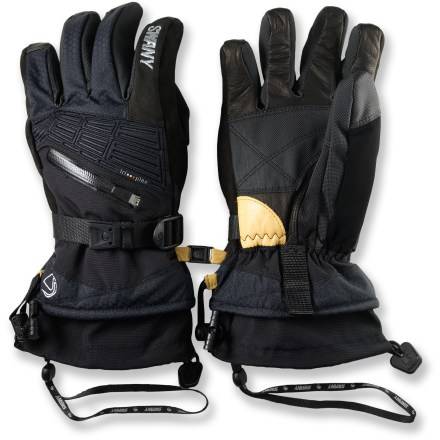 The X-Change II glove from Swany |
Good gloves are essential, and we’re big on a number of features that appear in the X-Change II from Swany ($85), like one-handed gauntlet operation, removable leashes, soft material on the thumb to squeege a goggle, and a zippered chemical heater pocket. Fingers have pre-curved box construction for comfort and dexterity, and a reinforced palm augments durability. Our only disappointment came when one of the gauntlet cinch cords snapped, but we were being pretty rough on them anyway in the name of testing.
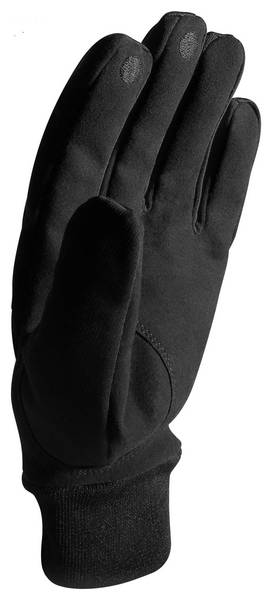 The Dots D200 glove Smartwool’s PhD Ski Medium The Meridian 75 from Osprey |
As many of our testers ski with mobile devices controlled by capacitive touchscreens (i.e., iPhone, iPod Touch, etc.) we really wanted to like Dots Gloves. Great in theory, Dots Gloves feature conductive yarns in three fingertips to allow you to scroll through your touchscreen without revealing your toasty digits to the elements. However, we found that their beefiest glove — the D200 ($25) — is inadequate for anything but spring skiing, when you wouldn’t mind removing a glove anyway. Add to that the fact that touchscreen performance was spotty at best, and we were frankly left disappointed.
point6 is a newcomer to the merino sock world, but we were duly impressed with the company’s Ski Pro Light ($19.95). We’re a fan of performance fit socks, and the Ski Pro Light had just minor padding around the achilles heel, underneath the heel and along the shin. Stretch bands around the ankle and across the forefoot keep the sock in place throughout the day and prevent bunching. Soft-spun merino wool sits next to the foot to prevent odor and moisture buildup. Those who need to pour themselves into their boots each morning will find the uncushioned Ultra Light Ski Sock more to their liking, while those with a more recreational boot fit will appreciate the added warmth and comfort of point6’s Ski Light or Ski Medium Cushion.
Another option for those who prefer a beefier ski sock is the PhD Ski Medium from Smartwool ($23.95). These pioneers of returning wool fabrics to the outdoors industry have produced a ski sock with higher density cushioning in the heel and metatarsal areas, medium cushioning in the heel and sole, and compression bands over the ankle, arch and instep to ensure lasting proper fit. Open mesh zones use a unique knitting pattern to pass moisture across the top of the foot, and the toe seam is flat-knit for comfort.
Properly designed luggage is something that’s often overlooked, but we were blown away by the Meridian 75 ($328.95) from Osprey. This Colorado-based backpack company, known for producing some of the most thoughtfully designed packs in the industry, has created a winner in this 75-liter piece of rolling luggage that’s perfect for toting your belongings on ski trips across the country or around the world.
What makes the Meridian 75 special is a detachable daypack complete with laptop sleeve that functions as a carry-on after checking the main vehicle with the airline. When you reconnect with your bag at your destination, you reconnect the carry-on to the main bag via a wrap-around zipper and four plastic buckles such that it becomes one solid piece of baggage again.
The Meridian 75 benefits from the Osprey design team’s attention to detail, including the best polyurethane luggage wheels we’ve ever encountered, plus a stow-away backpack suspension system for when pulling your bag isn’t an option. Comfortable carry handles are placed on both the top and side. The retractable handle feels comfortable in the hand, and even the four plastic compression buckles are covered with padding to foil the gorillas handling baggage for the airlines. The bag’s main interior is nicely compartmentalized to organize your stuff. About the only thing the Meridian 75 seems to miss is a hip belt for the carry-on, which seems odd as there’s a sternum strap and a hip belt would be a God-send when carrying heavy items.
We put the Meridian 75 through its paces on a cross-country journey that involved four flight segments and even re-checking baggage between two airlines. Sure it’s pricey, but in this world you sometimes get what you pay for.
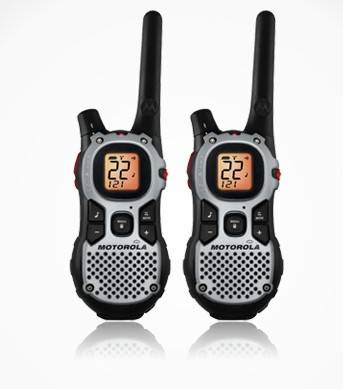 The new Motorola Talkabout MJ270R |
Mobile phones have supplanted two-way radios for communication for many skiers where cell service is available, but there are still many ski regions where cell phone coverage is spotty or non-existent. Motorola has introduced a new FRS/GMRS radio, the Talkabout® MJ270R that offers a 27-mile range under optimal line-of-sight conditions. Sure, few folks ski where mountain’s don’t create an obstacle, but in our testing the superior range of these radios was more effective than their shorter-range predecessors in leaping over mountain ridges. The MJ270R even includes an Emergency Alert Button, weather radio alerts, a backlit screen, and an LED flashlight for seeing in the dark around the campsite. While a rechargeable battery pack is provided, these radios can use alkaline AA batteries in a pinch. They can be recharged in the included drop-in desk charger or via any mini-USB cable. And frankly at $69.99 a pair with all of the aforementioned accessories, they’re a bargain, too.
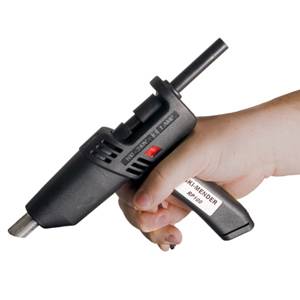 The Skimender RP100 |
With early-season conditions prevailing across much of ski country thus far this season, venturing off-piste can easily result in a core shot. And it’s nearly impossible to eliminate carbon from a traditional p-tex candle to create a good bond with your repair. A U.K. company named Power Adhesives has created a new p-tex repair gun called the Skimender, and we tested the consumer level RP100 version ($50-65). It looks like a glue gun into which specially-formulated and sized clear or black p-tex sticks are extruded into base divots. In practice we found the gun to be quite effective and rendering professional-quality ski and snowboard base repairs as long as you ignored the included instructions and let the device pre-heat for a good 20 minutes beforehand. It would have been nice if the tip allowed more material to be laid into the base wound at a time, but that’s a minor quibble. Power Adhesives kept the price down by eliminating a heated tip, but that’s available in the professional level RP360 tool at a significant price premium ($200-300). Using the Skimender is about as easy as a base repair gets.
When it’s time to clean that smelly baselayer, turn to Win Green detergent ($7.49). WIN Green is dye-free and fragrance-free and in our testing was extremely effective at removing perspiration odor from even the smelliest polypropylene. It works in all washing machines, with all fabrics and at all temperatures. For those concerned about their bodies or the environment it’s hypo-allergenic and biodegradable.
Backcountry
Packs, snow science, stoves and more…we dedicated a good portion of this year’s gear testing to backcountry favorites.
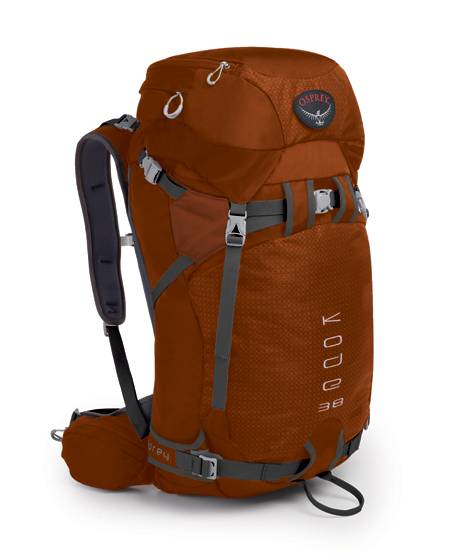 The new Kode 38 from Osprey |
Readers may have noticed by now that we’re a big fan of Osprey Packs’ design team, and they didn’t disappoint with the Kode series, the company’s new line of ski and snowboard backpacks which for this year has replaced the Switch series. We found the new Kode 38 ($159) to be one of the most thoughtfully designed ski-specific backpacks that we’ve ever used, and it’s now the “go to” pack for many of our testers. This 38-liter pack’s pre-curved backpanel provides superior support and unzips for back panel access to the main storage compartment, which is also accessible via a traditional rucksack entry. A separate portion of the main compartment keeps your snow safety gear at the ready and away from other belongings. The pack’s hip belt is wide and comfortable, and a tug on the strap pulls evenly across the hips. In testing, we found the suspension system superior at keeping things quiet while skiing. Reinforced ski carry is A-frame or diagonal, and the pack will effectively carry a snowboard or snowshoes as well. An expandable top pocket is roomy enough for a helmet while skinning or traveling to the slopes, and an insulated sleeve within the right shoulder strap helps to prevent hydration tube freeze-ups. Load lifters and side compression straps help to keep your 3 lb. 7 oz. pack at your back.
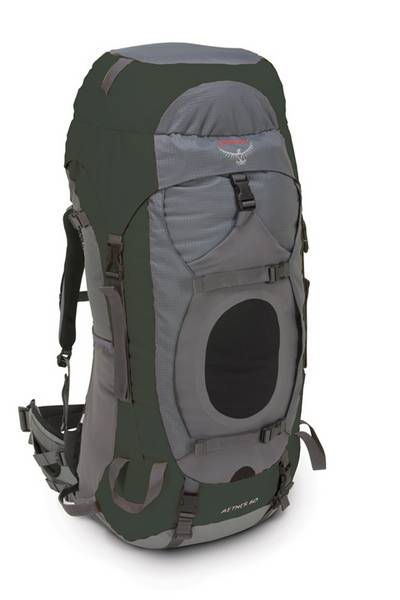 The Osprey Aether 60 |
For overnight or longer ski tours we also tested Osprey’s Aether 60 ($229) with its generous 60-liter storage capacity perfect for anything from hut-to-hut tours to winter camping. Ski carry is A-frame style via compression straps and a plastic-sleeved stretch loop that can double for climbing gear, but those using the Aether 60 are likely to be traveling uphill primarily on skins anyway. The pack’s Airscape backpanel provides ventilation while the Isoform CM hip belt can be custom formed to the owner for maximum support and comfort. The pack is a lightweight, barely tipping the scales at 3 lb. 4 oz. in the medium size. A stretch front pocket is big enough to carry a helmet on the ascent. While there’s no back panel access, a front zipper and a bottom zipper both augment the traditional rucksack access to the pack’s main compartment.
 The Cruise 30 from Deuter |
Another excellent choice for lift-served or sidecountry skiing is the Cruise 30 from Deuter ($144.95). Like Osprey’s Kode 38, Deuter’s Cruise 30 features full back panel access, internal probe and shovel sleeves and wrap-around compression straps. The Cruise 30’s back panel is nicely padded and includes a ventilation channel, and the wide hip belt includes gear loops and a reasonably generous pocket, but the shoulder straps lack an insulated hydration sleeve, surprising on a pack designed for winter use. The Cruise 30’s shining feature is wide and ridiculously beefy sleeves to accommodate an A-frame ski carry. Our testers enjoyed their time on the hill with the Cruise 30, which weighs in at 3 lb. 4 oz.
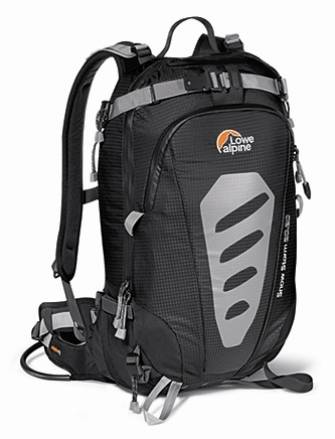 Lowe Alpine’s Snowstorm 20:20 |
Another excellent day pack option is the Snowstorm 20:20 from Lowe Alpine ($179.95). What’s remarkable about this pack is its ability to literally double in size — from 20 to 40 liters — by merely unzipping an expansion panel. Keep it tight and compact while riding the lifts, but expand it to its full capacity when heading into the backcountry. This 3 lb. 11 oz. pack features a suspension that’s adjustable for different size torsos, and the Adaptive Fit hip belt readily moves with the wearer. Again there’s no insulated hydration sleeve, and ski carry is in an A-frame configuration. A separate front pocket keeps snow safety gear handy at all times.
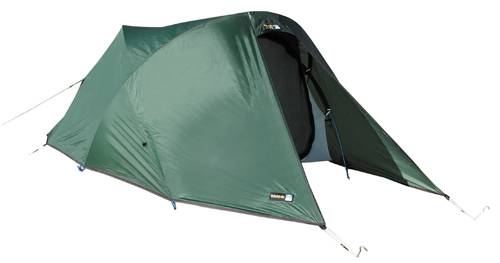 Terra Nova Designs’ Voyager |
For spending the night out in the field, there’s a new kid on the block this year, Terra Nova Designs. The company has a long history in Europe but is just now entering the North American market. We tested the company’s Voyager four-season two-man mountaineering tent ($600). Scalloped pole sleeves make pitching this tent’s DAC poles a breeze in the field. Relatively light for a four-season tent at 4.6 lbs., the Voyager is a traditional single wall plus fly design which we found quite stable in harsh weather thanks to its cross-over pole layout. Ventilation was adequate to prevent moisture build-up in winter conditions.
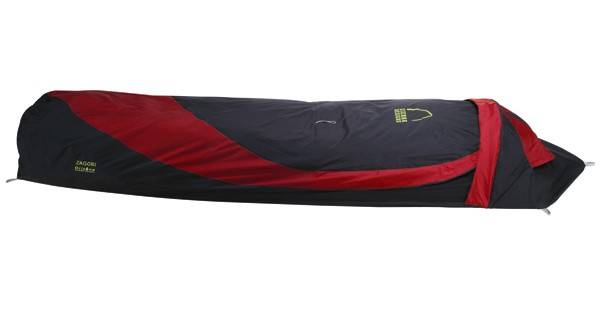 The Zagori Bivy from Sierra Designs |
Sometimes, however, you need or want to travel light, which calls for a bivy. The Zagori Bivy from Sierra Designs ($179) is lightweight shelter for one person that weighs in at 28 oz. (packed weight), features 100% welded seams for increased durability, and waterproof breathable fabric. Other features include a six-way zipper for head and arm access, wire hoop to raise shelter off your face, and stake out loops to keep you in place in foul weather.
While this bivy isn’t specifically targeted by Sierra Designs as a “four season shelter”, when coupled with the appropriate sleeping bag for the expected temperatures it could very easily serve that purpose. With its light weight, and waterproof/breathable fabric our testers thought it would work well in any backcountry ski pack as an emergency shelter or a shelter for overnight tours for the minimalist set — and you weight weenies know who you are! One tester said, “If you’re not the claustrophobic type this could easily be your every trip shelter, especially if you like to go light. The wire hoop helps to keep fabric off your face plus there’s lots of mesh, and that helps.”
The shelter breathes well and keeps the wet out. We experienced a light snowfall while we were testing and aside from a little condensation on the inside it did not wet from the outside and breathed better than expected.
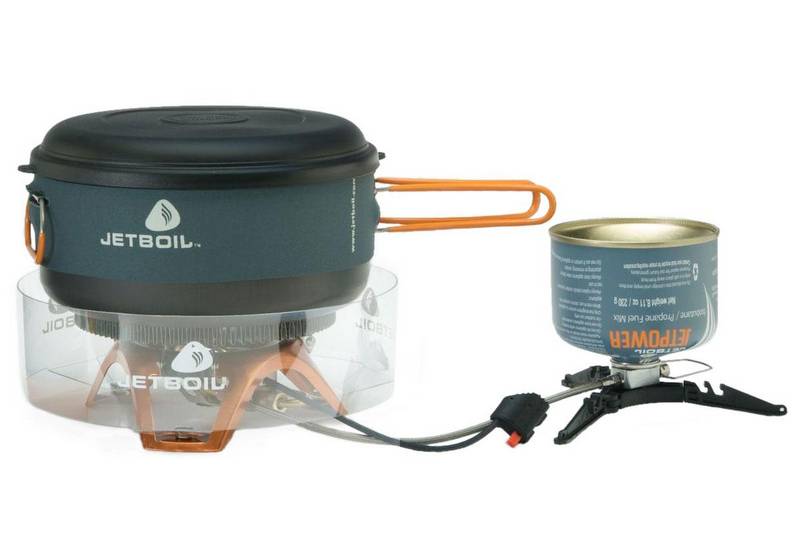 The Jetboil Helios The Jetboil PCS Petzl’s new MYO RXP headlamp |
Come dinner time, we’ve become fans of Jetboil’s family of backpacking stoves. We tested two of the company’s products, the Helios ($149.95) and the PCS Personal Cooking System ($99.95). The latter is convenient, compact and perfect for a solo traveler who’s merely reconstituting dehydrated meals. The former offers a larger cooking capacity, better for melting snow, and allows the user to invert the fuel canister for efficient operation at high altitudes and colder temperatures.
Both kits include the burner, cookware and serving ware (in the case of the PCS the cookware is the serving ware), and both feature the company’s FluxRing™ heat exchanger on the bottom of the pot to speed heating times and minimize fuel consumption. Everything nests together, including the fuel, in one neat package. And our testers fell in love with the French press coffee maker available for the PCS.
After dinner you have to be able to see around camp, and the new MYO RXP headlamp from Petzl ($120) casts a remarkable 160 lumens of light up to 97 meters on three AAA batteries — easily enough for a nighttime ski descent on open terrain. The MYO RXP is fully programmable to allow the user to choose between ten levels ranging from eight to 140 lumens, and regulating technology ensures that light level is maintained until batteries are nearly depleted. A diffuser may be selected to broaden the spotlight beam over a wider area, and the lamp may be operated on lithium batteries, which offer superior performance in colder temperatures. The whole thing weighs only 175g with batteries.
 Brooks-Range’s Igloo 35 folding snow saw The new Snow Density Gauge from Brooks-Range Mountaineering |
Most importantly, getting out there and getting back involves making informed decisions about route selection. Brooks-Range Mountaineering manufactures a variety of snow safety instruments, and this year we tested the company’s Snow Density Guage and Igloo 35 folding snow saw (each $49.95). The Snow Density Guage is a remakably simple device: insert a hollow tube into the snowpack, attach a graduated handle and hold up to read the snow’s water density on a scale. The Igloo 35 is lightweight (17.5 oz.) 30cm snow saw that folds down to approximately 12 inches while nesting its teeth to prevent catching on other items. It’s right-handed and attaches to ski poles, shovel handles, ice axes or other items to extend its reach. Its offset teeth can cut not only snow and ice but also wood as needed. It’s laser-etched with scales for snow crystal size as well as ruler measurement.
Entertainment
We can’t always be on the slopes, but we can always bring the slopes home.
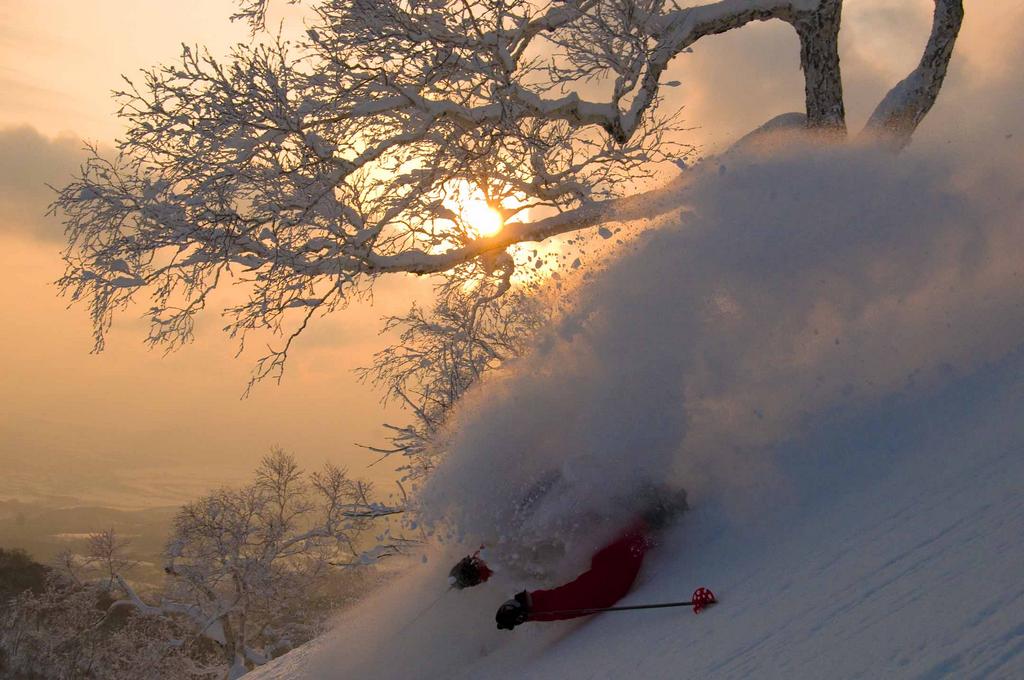 Forrest Coots rips a line in Niseko in this scene from Signatures, the new ski film from Colorado’s Sweetgrass Productions. |
Our favorite ski film this year is Signatures, the sophomore effort from Colorado’s Sweetgrass Productions that brings a new artistic flair to the ski film genre. With stunning, ethereal cinematography and a folk and roots rock soundtrack, Signatures eschews the brash, in-your-face terrain park antics and hip hop sound embraced by many of today’s ski filmmakers. It’s more mature. Even the storyline is unique, filmed entirely throughout a season in Niseko, on the northern Japanese island of Hokkaido. The film features athletes on alpine skis, telemark skis, snowboards and even “noboards,” exhibiting breathtaking athletic prowess on snowboards without bindings. Signatures follows Niseko athletes Atsushi Gomyo, Taro Tamai and Yoichi Watanabe as they ski, ride, and even surf and fly fish to capture the best of each season in Niseko.
Throughout, the cinematography is seductive, showcasing Hokkaido’s prodigious snowfall from unique angles through the lens of Jan Hock, Ben Sturgulewski and Nick Waggoner, always engaging the viewer and adding color to a largely colorless winter landscape. The film is now available on DVD for $24.95.
www.sweetgrass-productions.com
Older viewers will get a kick out of Cult Classics, a new box set from Egan Entertainment ($29.95) that re-releases such notable retro ski film favorites featuring John and Dan Egan as Return of the Shred-I, Extreme Dream, All American Free Ride and Where The Steeps Have No Name, along with episodes of Ski Bumology, Ski Bumming and more.
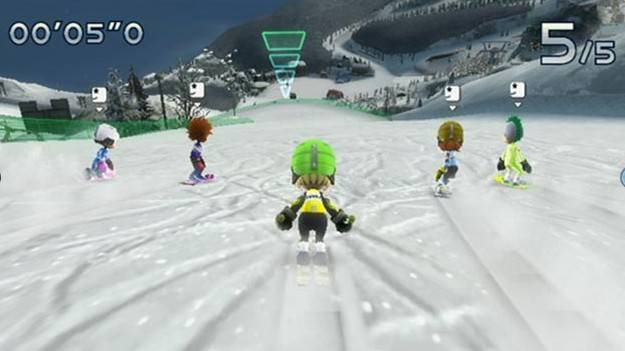 A screenshot from We Ski & Snowboard from Namco Bandai Games for the Nintendo Wii A Wall of White by Jennifer Woodlief |
And for a bit more interaction, our testers had a ball playing “We Ski & Snowboard” on the Nintendo Wii from Namco Bandai ($29.95). Designed to be played with the Wii Balance Board, our staffers explored various mountain landscapes, raced our colleagues, and in general made fools of ourselves, all in the name of good fun. It’s the use of the Balance Board that sets We Ski & Snowboard apart from other winter sports video games.
Finally, if curling up in front of the fire is your idea of après-ski, we enjoyed A Wall of White by Jennifer Woodlief via Atria Books ($25 hardcover) chronicles the tale of the deadly 1982 Alpine Meadows avalanche near Lake Tahoe. Woodlief chronicles the once-in-a-century cataclysmic event that claimed seven lives, tested the mettle of a rowdy but resolute team of rescue workers and ultimately proved a tale of triumph over death with the rescue of Anna Conrad, a young woman saved after five harrowing days spent trapped under the snow.

